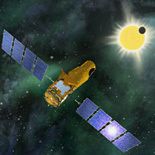-
 Diatomite
Diatomite
-
 Visual pollution
Visual pollution
-
 Anhydrobiosis
Anhydrobiosis
-
 Minitel
Minitel
-
 Renewable energy
Renewable energy
-
 Diphtheria
Diphtheria
-
 Acoustic crest
Acoustic crest
-
 Acusia
Acusia
-
 Exudation
Exudation
-
 Supergalactic coordinate
Supergalactic coordinate
-
 Torino scale
Torino scale
-
 PCI Express
PCI Express
-
 Deuterostome
Deuterostome
-
 Wood
Wood
-
 Acetyl-coenzyme A
Acetyl-coenzyme A
-
 Birds Directive
Birds Directive
-
 External fertilisation
External fertilisation
-
 Glucogenic amino acid
Glucogenic amino acid
-
 DSL
DSL
-
 Triangle galaxy
Triangle galaxy
-
 SNA
SNA
-
 3GPP
3GPP
-
 Covalent bond
Covalent bond
-
 Effinergie
Effinergie
-
 Container return scheme
Container return scheme
-
 Automaton
Automaton
-
 Ephemeris meridian
Ephemeris meridian
-
 Oncologist
Oncologist
-
 Liver fluke
Liver fluke
-
 Iguanodon
Iguanodon
Corot
The CoRoT space observatory (COnvection, ROtation & Transits planétaires), initiated by the CNES and implemented in partnership with the CNRS, the ESA, Austria, Belgium, Germany, Spain and Brazil, has a 27 cm afocal telescope and a wide field camera with four ultra-sensitive CCD detectors on board. Its mission: to study the internal structure of the stars in order to deduce their mass, their age and their composition, and to search for extra-solar planets around nearby stars.
Operation
CoRoT was launched on Wednesday 27 December 2006 at 14h23 UT by a Soyuz 2.1b rocket from the Baikonur cosmodrome and put into a circular polar orbit at 896 km inclined at 90°, an ideal situation from which it can continuously scrutinise any point in the sky for 150 days without the least interruption, and without being occulted by the mass of our planet.
Scientific questions
Corot's telescope is planned to successively observe five different parts of the sky thereby collecting a large number of measurements on the structures of thousands of stars. All this data will be extremely valuable because it will give direct access to the chemical elements making up the universe (which form in the stars).
CoRoT is also to carry out extremely high precision and long duration photometric measurements of stars likely to be orbited by planets. These can be detected by measuring the recorded photometric reading that will show the low variation in brightness caused by the passage of the planetary disk in front of its star.
If Corot discovers other planets many possibilities of inhabitable celestial bodies will be opened up. It could well be that bodies similar to the Earth could exist in other systems. By observing these other systems, scientists hope to improve their knowledge of the formation of our own solar system.
This stakes of this mission are both fundamental and twofold: detecting possible life forms and advancing the quest for our origins.

Corot
Latest
Fill out my online form.



